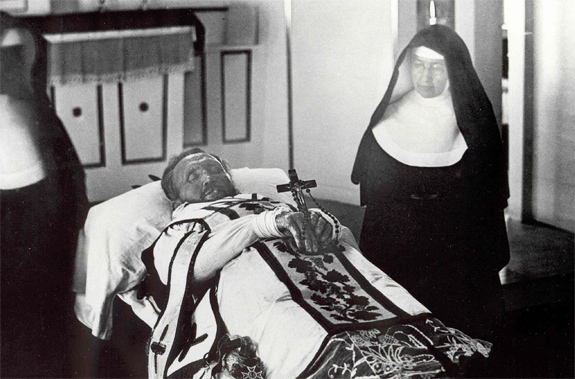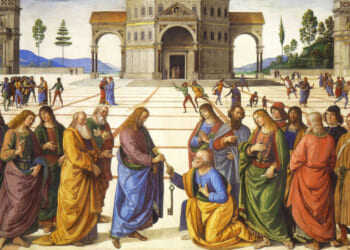
While Father Damien de Veuster had become somewhat famous by the time of his death, not everyone agreed that he was a holy man.
His bishop scoffed at the suggestion that Damien should be declared a saint, and a Protestant minister had publicly accused the priest of contracting leprosy through unchastity. Some of Damien’s religious brothers complained that he seemed to be endlessly trying to gain publicity for his mission, while others noted the high turnover rate among the assistants who joined him on Molokai. There were also allegations that the lepers of Molokai engaged in excessive drinking and promiscuous behavior, and some argued that he may have contracted leprosy simply through carelessness.
Does such a man deserve the title of saint, or is there more to the story of Damien de Veuster?
Joseph (Jef) de Veuster (1840-1889) was born in Tremelo, Belgium, into a faithful Catholic family. His father was a merchant and a farmer, and his mother often taught her eight children about the faith by reading to them from the lives of the saints.
Joseph’s favorite brother, Pamphile, was the smart one. Joseph himself was only an average student, but he was physically strong, hard-working, and friendly. When he was eighteen years old, his father sent him to a boarding school to learn French, hoping that it would help his son get ahead in business. But Joseph was not planning to become a businessman. He was thinking about becoming a priest.
A year later, Joseph had entered the same order as Pamphile—although without initially telling his father—in the Congregation of the Sacred Hearts of Jesus and Mary, also known as the Picpus Fathers. While he wasn’t the best student, he applied himself to his studies. He also took the name in religious life of Damien after the early Church martyr.
Damien took his years as a postulant and novice very seriously. After all, this training period would prepare him to be a priest as well as a missionary. True to his zealous personality, Damien imposed additional ascetic practices upon himself—such as sleeping on the floor, extending his time in prayer beyond what was required, and eating less meat—to prepare for whatever hardships he might face in his future mission.
The Congregation decided to send Damien’s brother Pamphile, who had just been ordained a priest, to the Hawaiian Islands. But just before his ship was about to leave, Pamphile became ill. Damien begged his superiors for permission to take his brother’s place, and they agreed.
When he arrived in Honolulu in 1864, Damien had not yet been ordained. But that was soon rectified, and then he and another priest were sent to serve a coastal community on the island of Hawaii. Damien’s territory covered a large area and included about three thousand Catholics. His physical strength came in handy as he crossed inhospitable territory carrying his “church” (i.e., a traveling altar) on his back to reach remote areas. He built church buildings with his own hands, learned the native tongue, and enjoyed living among the people he was serving.
Leprosy, which was considered deadly and incurable at the time, had been spreading rapidly throughout the Hawaiian Islands since 1860. Concerned that this disease would lead to an epidemic, the Hawaiian government established a colony for lepers on the island of Molokai. The colony was supplied with basic food and supplies and was geographically isolated by high cliffs and the ocean so that residents would remain segregated from others. Hawaiians who developed leprosy were supposed to turn themselves in. They were then transported by boat to spend the rest of their lives on the island. Barring a miraculous recovery, they would never see their loved ones or the outside world again.
Damien learned about the plight of the lepers on Molokai in 1873 when he attended the consecration of a large church in his diocese. The bishop, who was present, told all his priests about the dreadful conditions on Molokai Island. He also sadly mentioned that the colony did not have a priest. Damien volunteered.
He arrived at the colony on May 10, 1873. It was a tough adjustment. The stench of the rotting flesh of the inhabitants was overwhelming. Deaths were commonplace. Residents were living in shacks and felt isolated, alone, and abandoned. It’s not surprising that they gave themselves over to violence, orgies, alcohol, or other sinful and unhealthy activities to keep from thinking about the hopelessness of their situation.
But no place is hopeless when Jesus Christ is present. As a priest, Damien was able to offer them the sacraments, particularly the Mass. He also sought to improve their situation by repeatedly demanding that the Hawaiian government provide better material assistance and medical care.
However, the residents of Molokai did not initially appreciate Fr. Damien’s presence. They were hurting, hopeless people, and it took time for him to earn their trust and convince them that he loved them, so that they would believe that God loved them too.
Damien’s detractors then and now accuse him of being short-tempered. Yes, he angrily destroyed at least one homemade still; he knew that allowing his people to become addicted to alcohol would be dangerous to their bodies and their souls. He also strongly expressed his opposition to immoral behavior in his long, fire-and-brimstone sermons.
To curb their illicit relationships, he blessed marriages between residents of the colony. This led to complaints from his superiors that he was not as careful as he should have been in verifying that both parties in a marriage were free to marry. It is easy to believe that the lepers, who were considered as good as dead to their family members off the island, simply neglected to tell the priest about the spouses they had left behind.
Before Damien left for Molokai, he was repeatedly told that he should never touch the lepers or allow them to touch him to avoid being infected himself. But how can a priest serve people he cannot touch? Particularly the numerous orphaned children who looked up to him like a father?
At the time, there were tensions between Catholics, Anglicans, and Protestants, and often each Christian group supported only the needy who were members of their own group. Damien did not personally have a high opinion of non-Catholic practices and theology; he called some groups “heretics” in his private letters to his brother. But when donations came to Molokai for the residents, he distributed them equally to all, without discrimination. He also developed personal friendships with many non-Catholics who supported his work.
As the spiritual father and leader of hundreds of men, women, and children with leprosy on Molokai, he realized that if he did not constantly beg for food, clothing, building materials, and every other necessity, his flock would die in poverty. That’s why he endlessly pestered the Hawaiian government for assistance and looked for ways to publicize their plight. This publicity resulted in many donations and helped his people, but government officials deeply resented the implied criticism of their program.
Some of Damien’s superiors and brother priests also became jealous of the man who became famous all over the world during his lifetime. After all, his extraordinary work overshadowed their missions. One of Damien’s superiors was a particularly insensitive man who constantly criticized Damien and his actions. Damien accepted his superior’s insults in quiet obedience. Although his congregation’s rules required priests to be sent out in pairs, his superiors refused Damien’s repeated requests to have a brother join him on Molokai for many years.
When assistants did arrive, they often did not last long. Sometimes this was because the person recognized that God was calling him to serve differently. Sometimes it was simply too hard for the individual to emulate Damien’s example. While Damien’s days were focused on prayer, the Mass, and the sacraments, he also kept up an exhausting daily schedule which involved paying regular visits to the residents, building churches, digging graves, and tending their ulcers—all with his own hands.
After Damien’s death from leprosy, a Presbyterian pastor, who wrongly believed leprosy was the final stage of syphilis, publicly stated that Damien must have contracted the disease through sexual intercourse. This false accusation spread until the American writer Robert Louis Stevenson investigated Molokai, published a strong refutation, and turned the tide of public opinion back in Damien’s favor.
Unfounded rumors delayed Damien’s cause for canonization for many decades. But the people of Belgium were always honored to call him a native son. The Hawaiians could not forget his willingness to lay down his life for people with leprosy. And Mother Teresa of Calcutta would not give up begging Pope John Paul II to canonize Damien so that lepers and those who care for them would have a patron saint watching over them. In the end, who could say no to Mother Teresa?
Appearances can be deceiving. While some of Damien’s contemporaries looked at final photos of the dying man and saw only a man covered with the ugly ulcers of leprosy, subsequent generations have recognized something more profound. In Damien’s life, we see a man who learned to temper his zeal with prudence for the sake of his flock, a religious who swallowed his pride out of obedience to his vocation, and a priest whose faith in God brought hope to the hopeless. The leprous sores of Saint Damien de Veuster of Molokai, like the wounds of the Crucified Christ, were not his shame, but his crowning glory.
If you value the news and views Catholic World Report provides, please consider donating to support our efforts. Your contribution will help us continue to make CWR available to all readers worldwide for free, without a subscription. Thank you for your generosity!
Click here for more information on donating to CWR. Click here to sign up for our newsletter.









